Reserve Bank of Australia Annual Report – 1994 Financial Intermediation
Patterns of Intermediation
The pattern of lending was again skewed heavily towards housing in 1993/94. Over the year to June, loans for housing from all intermediaries increased by 23 per cent, following increases of 19 per cent in 1992/93 and 13 per cent in the year before that. The share of housing loans in total credit rose to around 37 per cent in June 1994, approaching double the share at the start of the 1990s.
Other components of credit – business lending and other personal lending – remained subdued for much of the year, although both showed signs of stirring towards the end of the year. Personal lending, other than for housing, rose by 4 per cent over 1993/94, compared with a fall of 1 per cent over 1992/93; credit outstanding to business fell by 1 per cent over the year, after a fall of 5 per cent in 1992/93. In the June quarter, personal lending was growing at an annual rate of 9 per cent, business lending at 1 per cent, and housing credit at 25 per cent. Total credit was growing at an annual rate of 10 per cent, its highest rate since the June quarter of 1990.
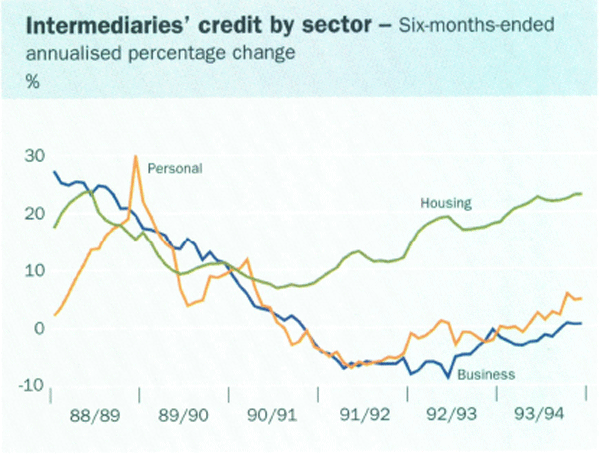
During the year, new products were introduced by banks which made it cheaper and/or easier to borrow for personal or business purposes against the security of a mortgage on residential property. Doubts have been raised about the classification of some of these loans; specifically, it has been suggested that some personal and business loans secured by mortgages have been incorrectly reported as housing lending, thereby overstating the recorded growth of housing lending. Investigations by the Reserve Bank, however, suggest that any such misclassification is very much at the margin – accounting for no more than 1 percentage point of the recorded 23 per cent growth in housing lending in 1993/94.
This imbalance in lending raises both macro and micro-economic policy issues. The former have been discussed already and the focus in this chapter is on some issues of the latter kind. Specifically, the main focus is on the reasons for the apparent bias towards the provision of housing finance; the extent to which business needs for finance, particularly those of small business, are being met by banks; and the profitability and competitiveness of banking in Australia compared with other countries.
Housing Finance
It is normal for some shift towards housing finance to occur during the early phase of recovery in the economic cycle. This is because housing demand is usually the first area to respond to lower interest rates. In the current recovery, however, the growth in housing credit seems to have been somewhat larger than the normal cyclical pattern would suggest, with factors on both the demand and supply sides contributing to this outcome.
The main factor has been the sustained high demand for housing loans over the past two to three years. Despite the present low-inflation environment, the Australian public has retained its strong attachment to property, both for owner-occupation and investment purposes. Its taxation treatment has always made residential property attractive, and this has been enhanced by mortgage interest rates being at single-digit levels for the first time in nearly two decades.
Banks have been able to accommodate this very strong demand without competing away the relatively profitable margins which exist on housing loans. Competition among banks for housing loans has been keen, but it has been conducted mainly in ways which have not affected the bulk of existing home borrowers – by, for example, offering discounts for the first year of new loans, and reducing fees for new customers. Competition in terms of the variable interest rates charged on the great bulk of housing loans has been much more limited, with the result that margins on housing loans – at least to this time – have remained high.
On the supply side, it is sometimes suggested that the Basle risk weights, which require banks to apportion only half as much capital to a housing loan as to a business loan, have been a major factor in driving bank lending for housing. It is claimed that banks can economise on their scarce capital by concentrating their lending on housing rather than on business borrowers. In other words, it is cheaper for banks to provide housing loans because they do not have to factor in as big a charge for capital (which is a relatively expensive form of funding) as they do for business loans.
This does appear to be a consideration in the minds of many bankers, but its significance in practice seems marginal. Consider, for example, how banks would apportion capital in the absence of the Basle risk weights. Good banking practice suggests that they would apportion their capital on the basis of the risks involved in each type of lending (or more precisely, the variability of the default experience in each type of lending). Those types of lending where the default experience was low and relatively constant from year to year, therefore, would require relatively small amounts of capital backing, while those exhibiting high and variable default experience would require larger amounts. Given that the default experience of housing lending is very low compared with business lending – a lot less than one-half – it follows that the incentive to engage in housing lending to economise on capital would be even greater in the absence of the Basle risk weights.
The proposition that the Basle weights bias lending towards housing holds true only if, in their absence, banks allocated similar amounts of capital to both low and high-risk forms of lending. It is unlikely that banks would act in that way. Even if they did, a move to the Basle risk weights would allow them to shave only half a percentage point off the housing rate and still retain the same rate of return as before. This seems to be too small a margin to explain the major growth in housing lending.
The Basle weights have been in operation in Australia since 1988. In the first two years, it was the very rapid growth in business lending which attracted most attention; the switch of focus to lending for housing has come to the fore only over the past three years of the strong cyclical recovery in housing. Moreover, all OECD countries adhere to the Basle weights, but many have not had a pick-up in housing lending. In those which have – such as the United States and Japan – the pick-ups have not been attributed to the Basle weights.
What is clear is that the margins on housing lending are especially attractive to banks, which is no doubt encouraging them to pursue such business. This can be seen from the various crude measures of the margin on housing lending and from the high rates of return being earned by the regional banks, which specialise heavily in housing lending. Competition so far has done little to whittle away these high returns but that would occur if existing borrowers were to shop around more actively for special deals (on which margins are lower) and if some lenders were moved to compete more directly on the variable rate itself.
For the moment, the main competition in terms of lower rates over the life of a mortgage, as distinct from “honeymoon” rates, is coming from outside the banking sector. Large insurance companies have offered mortgages at below the industry norm, as have several specialised mortgage brokers. Some regional banks have shown signs of being prepared to compete more vigorously on price outside their home markets.
On several occasions during the past year, the Bank indicated its concerns to the banks about the potentially adverse consequences of housing lending continuing to grow at rates of 20 per cent or more, particularly in circumstances where business credit – by far the largest component of credit – was showing signs of picking up. Those concerns have tended to focus on the implications for inflation and inflationary expectations, but they extended beyond that to other considerations, including a better balance in overall credit growth. They extended also to the possible implications for the banks themselves, and for their customers, when the inevitable correction to such rapid lending did occur. In the normal course of events the general operation of monetary policy would be relied upon to deal with potential problems in the housing sector (and in other sectors), but circumstances can sometimes arise when specific measures targeted at housing lending may also be appropriate. The implications of possible measures of this kind should obviously be explored with the banks before any firm decisions are reached. It is against that background that the Bank discussed some possible measures with the banks in early August.
Lending to Small and Medium Businesses
Whether banks were adequately meeting the needs of businesses, particularly small businesses, for finance is another issue which attracted considerable attention over the past year. Much of the decline in business credit outstanding over recent years reflected the weak demand for credit, combined with ongoing balance sheet restructuring, following the over-gearing in the late 1980s. Businesses have used their cash flows to repay loans; they have tended to defer investments and, where possible, they have sought to raise more equity finance on the back of rising share prices. (The non-financial corporate sector raised $17 billion in new equity in 1993/94, roughly double their raisings in the previous year.) At the same time, weakness in demand for credit may not have been the whole story, as the banks appeared to direct less energy to their business lending (especially to small businesses) than they did to their housing lending.
The Bank has taken some steps to improve its understanding of relations between the banks and small business borrowers, and to encourage banks to lend more to business. The non-callable deposits (NCDs) held with the Reserve Bank were adjusted so that the banks have received, from 1 July 1993, a market rate of interest instead of the below-market rate paid previously. This was estimated to add about $140 million annually (before tax) to banks' income, which the banks agreed to redirect largely towards small and medium-sized business borrowers. To put it in perspective, this “benefit” to the banks compares with outstanding loans by banks to small business borrowers of about $45 billion; if it were applied entirely in lower loan interest rates on loans to this group of borrowers, it would involve a reduction in interest rates of about 0.3 of a percentage point. It is therefore difficult to quantify the banks' response to this (relatively modest) change. It is the Bank's view, however, that the change has encouraged banks generally to seek business borrowers more keenly than before; the larger banks have instituted or improved special offers for small business borrowers while several smaller banks, not previously involved in this market, are now looking to increase their business lending.
Better information on bank lending to small business is now being collected. Two surveys were commissioned by the Bank to help gauge small businesses' general attitudes towards banks and their actual experiences with banks. Like most other surveys of this type, these found that, overall, a lack of debt finance was not a major constraint on the operations or expansion plans of small and medium businesses at this time. The surveys identified several irritants, not related directly to the cost or availability of finance, which sometimes soured relationships between banks and small businesses. These included poor service, a perceived lack of interest and understanding on the part of banks, the absence of follow-up by banks, and a belief that banks rely too heavily on security in assessing loan applications.
A new quarterly collection of statistics from the banks on their lending to small businesses was also instituted and the results published in the Reserve Bank Bulletin. Among the data available is a classification of the size of loans by the average interest rate charged. This shows that smaller borrowers tend to incur higher interest rates of the order of 1½ to 2 percentage points, depending on the type of loan. These differences do not appear to be unreasonable, given that smaller businesses generally involve higher risk, in part because they tend to be newer and have a much higher ratio of borrowings to turnover than larger, established businesses. In addition, the basic costs of establishing and monitoring smaller loans are not much lower than in the case of large loans and, to the extent these costs are not recovered fully through establishment and maintenance fees, banks have another reason for charging higher interest rates.
Weighted average interest rates to business
(March 1994)
| Smaller businesses | Larger businesses | |||||
|---|---|---|---|---|---|---|
| Under $100,000 |
$100,000 to $500,000 |
Average |
$500,000 to $2 million |
Over $2 million |
Average |
|
| Variable-rate loans | 11.1 | 10.7 | 10.9 | 10.3 | 9.4 | 9.8 |
| Fixed-rate loans | 10.2 | 9.8 | 9.9 | 9.5 | 8.2 | 8.6 |
| Bill facilities | 8.3 | 8.2 | 8.2 | 7.8 | 6.5 | 6.9 |
Finally, a small business panel consisting of principals of small businesses operating in all States and covering a range of industries was established to provide advice to the Bank. The panel, which meets at six-monthly intervals, provides the Bank with first-hand information bearing upon the financing needs of small businesses, and their relationships and problems with the banks.
From the information available to the Bank, it seems clear that most smaller businesses with viable proposals are able to obtain the debt finance they require, although they are not always satisfied with the cost or security or other conditions associated with particular loans. Of more concern was evidence of deficiencies in banks' understanding of their customers' business operations, which has no doubt resulted in some viable proposals failing to get bank finance. At the same time, it is apparent that smaller businesses often lack sufficient financial and management expertise and do not always appreciate the information requirements of banks in assessing loan applications. Considerable effort is now being invested by banks, governments, industry bodies and accounting firms in trying to overcome these shortcomings.
Intermediaries' Interest Rates
Interest rates on the banks' main loan products – variable-rate housing and business loans – were reduced following the reduction of half of a percentage point in cash rates in July 1993, and have been held steady since then. Interestingly, most banks have set and held similar rates on these loans. For variable-rate housing loans, all the major lenders have charged 8.75 per cent. Indicator rates of the four major banks for variable-rate business loans have been generally at 9 per cent on loans to large customers and 9.25 per cent on loans to small and medium customers, although actual rates charged would be higher, reflecting the risk margins attached to different groups of customers.
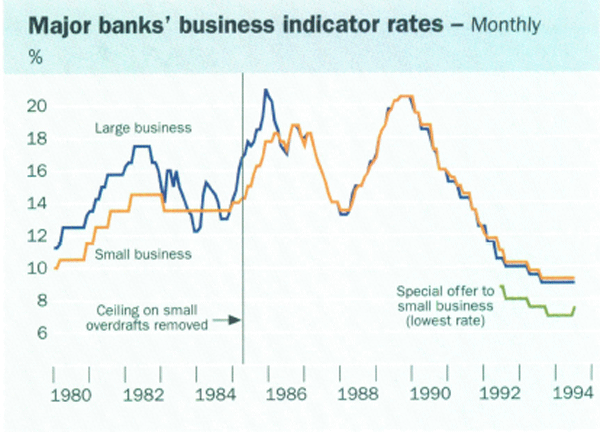
As noted earlier, most of the competition among banks on rates was in respect of the special offers on housing and business loans. On housing loans, special discounts of up to 3.25 percentage points on the standard rate of 8.75 per cent were offered to new borrowers, although usually only for the first six or twelve months of the loan. As such, they made little difference to the effective loan rate over the full life of the loan. A reduction of 3.25 percentage points for one year, for example, reduces the effective rate over a 20-year mortgage by about 0.2 of a percentage point. If the loan was kept for seven years (which is about the average life of a loan), the reduction in the effective rate would be about 0.5 of a percentage point. In the case of business loans, some banks offered discounts of around 2 percentage points to new customers, generally over the life of the loan.
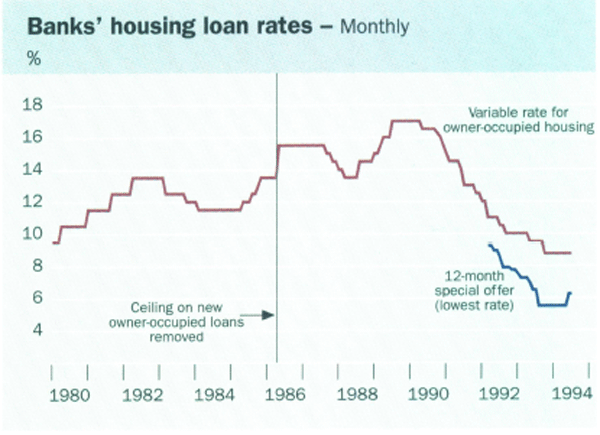
Fixed-rate housing loans gained in popularity during the past year, although they remain relatively less significant than variable-rate loans. Some 5 to 10 per cent of housing loans are made at fixed rates, along with about 25 per cent of business loans. Interest rates on new fixed-rate loans – which are funded by medium to long-term borrowings in wholesale financial markets – fell a little in the first half of the year in line with market yields, but rose sharply in the second half, as bond and other market yields rose. Interest rates on new five-year fixed-rate housing loans, for example, rose by up to 2 percentage points between May and July, to an average of about 11 per cent, similar to where they were a year earlier. Interest rates on medium-term fixed-rate loans to business rose by a little more, to around 11.5 per cent.
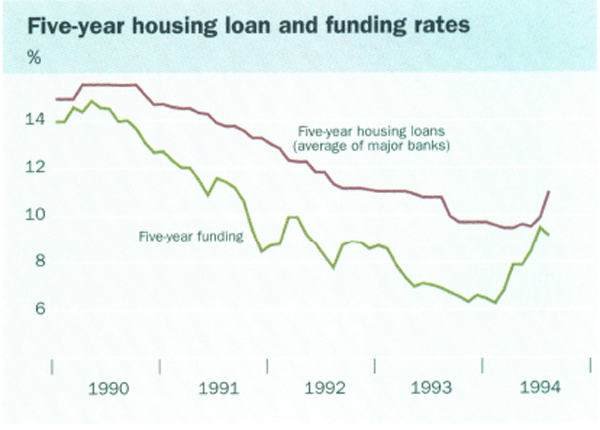
As well as fixed-rate loans, banks also offered a greater range of options for managing interest rate risk, including caps on loan interest rates and split-loan facilities where borrowers could choose to have part of a loan at a fixed rate and part at a variable rate. Some lenders introduced more flexible repayment schemes for housing loans which allow borrowers to exceed required payments and subsequently draw them down again (where borrowers are ahead of scheduled loan repayments).
New personal loan products were introduced and some significant reductions occurred in personal loan rates. Several banks now offer personal loans at home loan rates where the loan is secured by a residential mortgage; this is equivalent to a saving of around 2.5 percentage points on the standard variable rate on unsecured personal loans. Following the changes in consumer laws which enabled banks to introduce user fees, interest rates on credit cards have declined; typical rates on credit cards with an interest-free period were cut from 20 per cent to 14.5 per cent and an annual fee of around $20 applied, delivering significant benefits to large numbers of consumers.
On the deposit side, interest rates offered by banks on very short-term deposits were reduced in line with the reduction in cash rates in July 1993 but remained steady thereafter. After declining slightly early in the year, rates on term deposits rose by up to 2 percentage points in the second half of the year, in line with rising security yields and swap rates in the wholesale markets.
Overall, the cost of funds to banks fell by less than loan rates, with the result that banks' average interest spreads declined. The gross domestic spread of the four major banks was 4.4 per cent in the first half of 1994, 0.2 of a percentage point narrower than in 1993 and the previous two years. After taking account of the reduction in non-performing loans, the net spread was a little under 4 per cent, much the same as it has been since 1990.
Bank Interest Margins
Public interest in bank margins – that is, the difference between what banks charge on their loans and what they pay on their deposits – persists. The concerns initially were that the banks were not passing on the full extent of the reductions in official interest rates which commenced in 1990 but were, instead, increasing their margins to make good earlier loan losses. In its submission to the Martin Committee, the Bank concluded that there was no evidence of any widening in margins; if anything, there was a slight downward trend in the margin between the average interest rate charged for loans and the average interest rate paid on deposits.
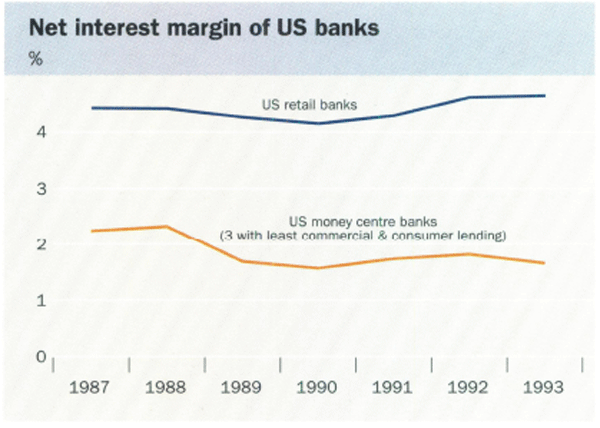
The Bank's conclusion, which has been confirmed several times since, did not imply any judgments about the appropriateness of the level of interest rate margins in Australia. Others have suggested that the margins of Australian banks are high by international standards. The Bank has expressed scepticism about the value of the data underlying existing international comparisons and, indeed, about the prospects of deriving any entirely satisfactory comparisons of this kind, given the structural and institutional differences across countries. Nevertheless, the Bank has attempted to compile data on margins for the four majors in Australia and for categories of roughly comparable banks in a number of other countries; the results are summarised below. Despite its best endeavours, however, the Bank believes its comparisons remain subject to major shortcomings. This is perhaps best illustrated by the fact that the variation in margins among banks within each country is often larger than the variations from country to country.
Comparable banks in different countries do not select themselves. Some types of banks can operate on very low margins, while others need quite high margins to achieve the same degree of profitability. The big US money-centre banks, for example, which rely almost exclusively on large-scale wholesale business and fee income, can operate profitably on an interest margin of less than 2 per cent, whereas full-service retail banks in the United States normally require margins in excess of 4 per cent. The results of any comparisons with the United States, therefore, will be affected by the types of banks included in the US sample. If the sample was weighted towards money-centre banks, the average margin would be a lot lower than if it was weighted towards full-service banks. This potential source of distortion is also quite important in respect of Japan and, to a lesser extent, some other countries.

Another major problem concerns the mix between banks' domestic and foreign business. In almost all cases, banks' foreign business tends to be concentrated in wholesale financial markets, and to operate at finer margins than their domestic business. Selections of banks which do a lot of offshore business will therefore tend to show lower average margins than for selections of banks which concentrate more on domestic business. To indicate the magnitudes involved, the average margin of the major Australian banks on their offshore business is about 2 percentage points lower than the average margin on their domestic business.
To minimise the first problem, the Bank has sought to include for each country only major full-service banks – that is, banks which provide a full range of services to households, small businesses and large businesses. To tackle the second problem, the activities of all selected banks have been measured on a domestic consolidated basis. For Australia the sample covers the major four banks, for the United Kingdom the four high-street banks, for Canada the five major nationally operating banks, for the United States the 40 largest retail banks, and for New Zealand four large multi-purpose banks. Efforts were made to include some Continental European countries but reliable data on a domestic consolidated basis were not available. As it is, the data for the countries covered are affected by various differences in national accounting practice which could not be overcome. To provide one illustration of this, Australia's major private banks reported total after-tax profits of $1.4 billion in 1993 on Australian accounting standards, but $1.1 billion if US standards had been applied – all of which cautions against drawing firm conclusions from small differences in the various ratios.
The term “interest rate margin” usually refers to the difference between the interest rate charged by banks on their loans and the rate they pay for their deposits. The information is not normally available in this form for the whole of banks' domestic business, but it can be approximated by another measure – the net interest margin – which can be obtained from banks' accounts. The net interest margin shows net interest income (interest received minus interest paid) divided by total interest-earning assets.
The comparison shows that all countries in the sample, except the United States, have had a downward trend in their net interest margin over recent years. In 1993, margins ranged from 3.0 per cent to 4.6 per cent. Margins in Australia were towards the top end of that range – at 4.4 per cent, the second highest after the United States.
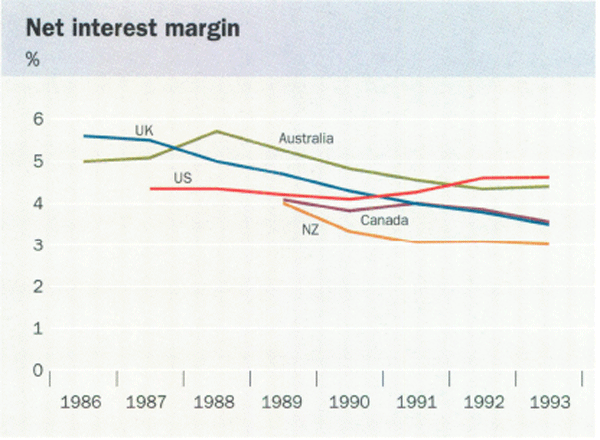
The interest rate margin is the main way in which banks earn their income, but it is not the only way. Banks also derive income from fees and charges, and, to a lesser extent, from trading profits on their Treasury operations. A comparison of gross income to assets allows these other forms of income to be taken into account. This comparison shows margins for 1993 ranging from 4.7 per cent to 6.2 per cent, with Australia in the middle of the field of four (the UK statistics did not permit this comparison).
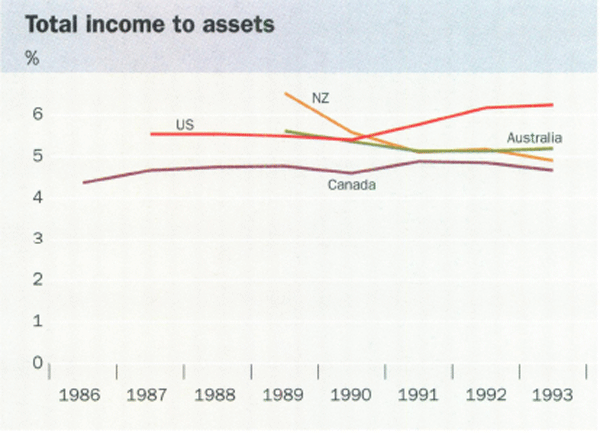
The fact that Australia had a higher relative position on the basis of net interest margin than on the basis of total income suggests that Australian banks derive a smaller-than-average share of their income from fees and charges than do banks in the other countries covered. Direct evidence on fees and charges supports this conclusion; among other things, it suggests a greater degree of cross-subsidisation of certain banking activities in Australia compared with some other countries.
The broadest, and probably most meaningful, comparison is to look at the ratio of total profits to assets. This ratio shows considerable year-to-year variation, so a measure of underlying profits is used, namely profits before provisions and taxes. The range across countries for this ratio was 1.5 per cent to 2.2 per cent, with Australia again in the middle of the field.
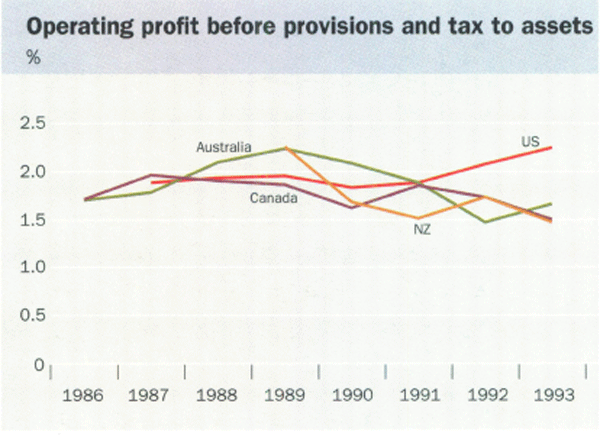
Overall, these comparisons suggest that total income and profitability of Australian banks are in line with comparable full-service banks in other countries. What is different in Australia is the mix of income – interest margins tend to be high while non-interest income tends to be low. A likely explanation for this is that the interest margin is being used to subsidise other types of activity, particularly those concerned with payments transactions. One way, therefore, to reduce the average interest margin would be to make greater use of fees and charges. Another way would be to reduce the costs of providing some bank services, although on the basis of the Bank's comparisons banks in Australia do not appear to be out of line with those in other countries. As competition increases, it is expected that interest margins will be squeezed through both these channels, but that will take time.